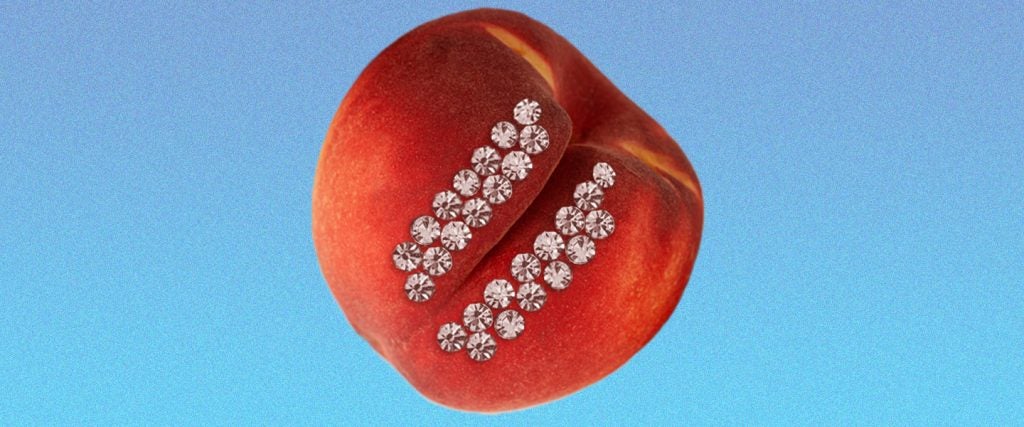Every so often, when a cultural phenomenon suddenly bursts into public consciousness, it becomes unfathomable to recall life before it existed (fidget spinners or Crazy Frog are notable examples). But then, poof, all of a sudden it’s gone, and you’re left wondering: Why!!!
The vajazzle is one of these phenomena. All of a sudden, in 2010, the concept of vajazzling — a portmanteau of vajayjay (meaning vagina) and bedazzle — was everywhere. It involves, as I’m sure you’ve guessed, decorating your genitals (most commonly, as Wikipedia elegantly states, “on the shaved mons pubis of a woman”) with rhinestones, Swarovski crystals or cheap little gems, depending on your price range. They usually last around five days, and are done for aesthetic purposes only, bringing no benefits whatsoever when it comes to sexual pleasure. When it comes to design, you might opt for a phrase like “SEXY BITCH,” a nondescript pattern or a cute shape, like a heart. If you join the eight-member — now seemingly defunct — Vajazzle subreddit, you’ll also find Christmas vajazzles, mustache vajazzles and people urging those who get the treatment done to “jump into a volcano.”
It’s hard to pinpoint exactly who invented vajazzling, but the general consensus is that we have Jennifer Love Hewitt to thank, who, for some reason, dedicated a whole chapter to vajazzling in her 2010 dating advice book, The Day I Shot Cupid. In a January 2010 promotional interview on Lopez Tonight, Hewitt explained how she got into vajazzling: “After a breakup, a friend of mine Swarovski-crystalled my precious lady, and it shined like a disco ball, so I have a whole chapter in [my book] about how women should vajazzle their vajayjays.”
Just weeks after Hewitt popularized the procedure, Cindy Barshop, now the founder of vaginal spa VSPOT, gave an interview in which she revealed that her hair removal spa Completely Bare had been doing vajazzles for years — only they called the treatment “Completely Bare with a Flair.” “As women began to visit Completely Bare [for hair removal treatments], I noticed that their confidence began to rise,” Barshop tells me. “Women were starting to feel more comfortable making decisions that involved their intimate areas. Due to this, I decided to introduce new treatments that would build on the confidence of women and make them embrace their bodies so much more, curating the vajazzle.”
Statistics about the popularity of vajazzles in the U.S. are few and far between. But Washington City Paper suggested at the time that vajazzle specialists started to “pop up everywhere,” and The Cut recently reported that Google searches took off immediately after Hewitt’s interview — though no other mainstream celebrity appears to have endorsed the trend. “Vajazzles were very popular at the time due to the rise in beauty and wellness and celebrity culture,” says Barshop. “Clients wanted something new, fun and sexy. Vajazzles opened a whole new sector of beauty that had never been seen before. During this time, people were also trying to figure out how to not only talk about sex, but also express themselves, which the vajazzle helped with by allowing women to embrace who they were.”
Paulina Szmydke-Cacciapalle, the editor-in-chief of beauty industry reference platform BEAUTYSTREAMS, suggests that 2010 “saw the first signs of body parts being abstracted and viewed as separate, organic entities.” “Certainly influenced by third-wave feminism, women were increasingly embracing their sexuality as a way to take back their power — though the beauty tools to do so were still limited,” she tells me.
It wasn’t until December 2010 that the concept of genital bling would finally permeate the U.K., finding what I regard to be its true home in the county of Essex — where, for those who don’t know, hair extensions, fake eyelashes, tans and general glamour reign supreme. The vajazzle was first introduced in an episode of the reality TV show, The Only Way is Essex (aka TOWIE), when beauty therapist Amy Childs agrees to do one for co-star Sam Faiers. Explaining the procedure, Childs says, “People have it done, like, wax their pubic hair in a little heart stencil, then have a few diamonds around it.” Later in the episode, we see Childs give Faiers her “sexy scattered” vajazzle. And voilà, the vajazzle took the U.K. by storm, with sales of the tiny gems “soaring,” according to the tabloids at the time.
One person who took a chance on shop-sold gems — as opposed to getting the treatment done in a salon — was Tennessee-based Leanne (not her real name). She first heard about the vajazzle when she was 15 after seeing a photo of one “with some cool pattern” on the anime-themed social networking site Gaia Online. But it wasn’t until she was 17 that she finally tried it — and when she did, it didn’t go to plan.
“I did zero [research] other than [looking at] pics,” she says. “I couldn’t go to a pro because my mom would be like, ‘Hell no,’ so I proceeded to glue rhinestones to my bits to be all fancy — with no shaving or grooming prior.” Shortly after starting her DIY procedure, Leanne says it started to burn. “I freaked out and tried to rip them off,” she recalls. “But it didn’t work fully, so I had these glue-covered bits stuck to me.” Although she managed to avoid her mom finding out, Leanne “had rhinestones stuck in [her] pants for like two weeks straight. I was lucky to have no scarring.”
Although those who got it done by a trained professional might have fonder memories than Leanne, as with anything, the vajazzle’s shelf life was short-lived, now basically being obsolete (despite tabloid declarations to the contrary). But what led to its downfall? “I stopped offering the vajazzle treatments around 2017 because I saw that styles and trends began to shift,” explains Barshop. “As time progressed, women began to move toward natural and holistic methods that focused on their overall intimate health, which didn’t really fit with the bedazzling approach that the vajazzle offered.”
According to Szmydke-Cacciapalle, today, “rather than camouflaging imperfections, it’s about catering to the V area and imbuing it with a post-workout, yoga-like glow” — something that’s been “buoyed by the growing body positivity and well-being movements” as well as by the “new generation of brands” who’ve “shaped their offerings around the concept of pampering.” Szmydke-Cacciapalle says people are more focused on things like “BB creams made for down there, which promise to reduce the look of hyperpigmentation,” “cue drops, which provide a plumping effect in the labia region” and “vulva-celebrating sheet masks to combat redness, inflammation and irritation often caused by grooming or intimacy,” which, she adds, might have previously been “covered up by rhinestones or the like.”
But as cutesy Y2K trends like tooth gems and rhinestone or fairy hair make a comeback among Gen Z, who’s to say the vajazzle won’t be next?
Barshop is skeptical, but believes a new form of vajazzling could one day spring up. “Since 2010, beauty trends and standards have changed immensely,” she tells me. “Now you have women focusing on products and treatments that are eco-friendly, natural, sustainable and organic. I believe that nothing is out of style forever, so there is a possibility that a more enhanced version of vajazzling may return — but one that meets emotional and environmental requirements.”
So, there you have it — maybe all we need to get our razzle dazzle back is a little eco-friendly vajazzle.

